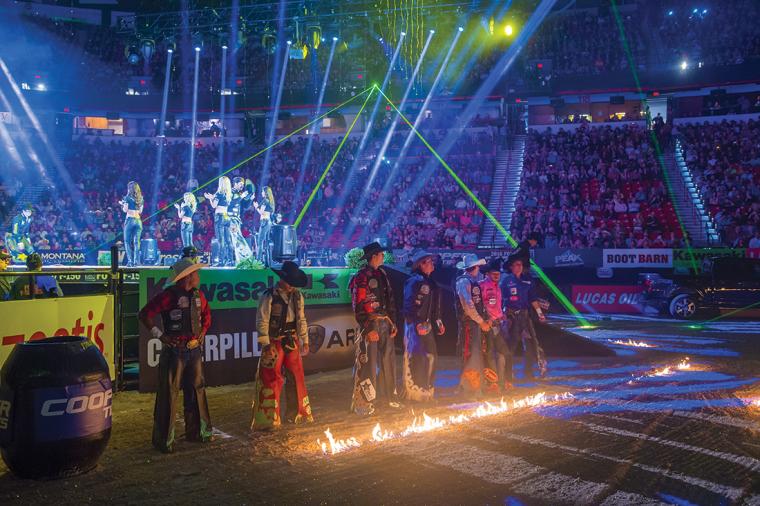
Whether responsible for planning and executing an annual community 5K race, charity golf outing or a professional league championship like the MLB World Series, keeping a recurring event fresh or novel can be challenging. Typically, with recurring events, the operational structure is set in terms of when and how activities occur which requires the individual or team responsible for organizing the event to simply replicate the sequence of activities with adjusted timelines. One of the more challenging tasks is adding an element of freshness to the event that occurs cyclically or seasonally.

When organizers fail to create the perception of novelty or excitement, recurring events are prone to be labeled as stale or boring. There is a greater likelihood of stale events having a negative impact on participation, attendance and sponsorship. Failing to apply innovation and creativity can lead to adverse consequences. Even a fitness or training session that occurs monthly or quarterly at a local recreation facility can benefit from a fresh twist to improve the potential to attract new clients and maintain current participation. No event that takes place on a recurring basis is free from being scrutinized for appearing stale and mundane.
There are many reasons why event organizers are creating value-added options to the main event. Depending upon the type of add-on creation, opportunities exist to increase interest and brand exposure, diversify participation, attract new spectators and sponsors, expand the geographic footprint of an organization, create new revenue streams and demonstrate community support and corporate social responsibility (CSR).
Examples of add-ons for recurring sport events include tailgating options, on-location experiences, firework shows, concerts and hospitality tents with limited seating. Carnival games, inflatables, autograph sessions, trivia contests, cooking contests, access to the field (e.g., youth run the bases), skills clinics, pre-game radio-hosted shows or meet-and-greets also provide incentives for individuals to participate or attend the main sport event. College Game Day, the rotating weekly televised football pre-game show, routinely attracts record crowds at a stadium.
Recurring events that occur in different locations (e.g., FIFA World Cup, NCAA March Madness) have an extra advantage from the attractiveness of a distinct city (or country) that can be marketed. There are greater challenges in maintaining the freshness of recurring events that are always in the same location. For example, The Kentucky Derby will always be held at Churchill Downs and the Flying Pig Marathon will always be held in Cincinnati, Ohio. What makes these annual events in the same location every year extra special are some of the tie-in ancillary activities created for additional enjoyment such as a mint julip tasting (Kentucky Derby) or a flying fur race for pets (Flying Pig Marathon). These value-added activities engage audiences and sponsors beyond the core event. Additionally, activities provide incentives for fans, spectators and participants to purchase tickets in advance, arrive early or stay late.
Teams playing in the same facility the entire season benefit from providing ancillary events and diverse activities in and around the venues to better engage spectators. Battery Park, situated around the Atlanta Braves Truist Stadium and Hensville, nestled between the Toledo Mud Hens and Walleye home facilities, have extended the opportunities for spectators to enjoy the convenience of the game location. In the same vein, ancillary spaces such as pop-up restaurants, food trucks, photo or banking kiosks and in-venue sportsbooks increase the footprint of a facility and add to the attractiveness of an event or a location.
Facilities have the opportunity to create partnerships with vendors, city agencies, schools, local businesses and even national or international brands to provide or contribute funding, staffing, equipment or operational needs for conducting ancillary activities in conjunction with a recurring event or game. These relationships may be gratis or commission-based depending on the nature of the agreement and goals to promote corporate social responsibility, increase brand exposure or procure diverse revenue streams.

Experiential or engagement marketing represents activities that engage audiences and provide real-time, memorable experiences. Brands and rights owners are often centerstage at live events designed to promote main events. Capital One, for example, is the presenting sponsor for both the 2023 NCAA Final Four Fan Fest in Houston, Texas in conjunction with the Division I men’s basketball championships and the 2023 MLB Play Ball Park in Seattle, Washington which precedes and coincides with the All-Star Weekend. Both events occur before and during the main event offering live entertainment, free clinics, autograph sessions, celebrity appearances and a carnival atmosphere described as a “sports wonderland of
interactive games.”
Some experiential marketing experiences occur as a traveling exhibition. Perhaps the best example of this type of live tour-style experience is the year-long torch relay preceding the Olympics. The coordinated global activation of torchbearers in hundreds of cities throughout the world escorted by an entourage of entertainers and staff accentuates culture and local pride while providing optimal marketing and promotions for the upcoming main event.
Similarly, the national traveling expedition for the Negro Baseball League is a signature experience promoting the main museum open throughout the year in Kansas City, Missouri. These tour experiences allow potential consumers to build anticipation and develop a connection with the main attraction, which contributes to the goals of engaging audiences and keeping events fresh and exciting.
Dr. Dexter Davis, Professor of Sport Business at the University of Tennessee at Martin and a member of the non-resident faculty at the United States Sports Academy, has over two decades of experience involving students in the NFL Super Bowl and its On-Location Experience (OLE) described as an interactive football theme park. The On-Location Experience begins approximately a week before the Super Bowl. Davis offers five strategies to engage audiences and keep an annual sport mega-sport event such as the Super Bowl fresh for spectators, media and even players.
(1) Consider the Location:
The Super Bowl is always held in a different location each year, that fact alone helps make the reoccurring events fresh. Add in the fact that many of the recent stadiums are new or have had major updates, the venues themselves are new and fresh. There is a reason the International Olympic Committee (IOC) utilizes a bidding system to secure host cities for the summer and winter Games. Destination locations are an added attraction beyond the core event and an incentive for sports tourism. The locations and venues for the National Senior Games and the NCAA Convention, for example, rotate annually to different geographic destinations. Similarly, teams and leagues have featured games in unusual locations. For example, the NHL has held games on an aircraft carrier and at both an NFL and MLB stadium; the MLB hosts the “field of dreams” game in a midwestern cornfield; the WNBA has played a game at Arthur Ashe Tennis Stadium and Radio City Music Hall in New York; collegiate football games have been held in MLB stadiums, collegiate hockey games have been held in football stadiums and a professional tennis match was once staged on a helipad in Dubai.
(2) Add a Theme/Logo:
The Super Bowl On Location Experience uses professional designers and always incorporates a new logo and new and exciting themes for their programs and venues. The Super Bowl plays on multiple themes, whether it is the host city or a special year such as Miami accentuating the NFL’s 100th year or Los Angeles incorporating Hollywood Stars. For the 2023 Super Bowl in Arizona, the design of the official logo focuses on the state’s desert features and incorporates the colors turquoise and purple. An event may recur every year but the artistry, colors and design of signage, marketing materials and staff wardrobe can add a sense of freshness.
(3) Diversify Activities:
The value of providing diverse, auxiliary activities to liven up a recurring event cannot be overstated. Diverse levels of “experience” are offered at the Super Bowl On Location Experience to allow the sales staff to cast a wider net and attract a wider audience. There are basic activities that draw a different clientele from that of the elaborate “On the Fifty” experience where fans may have pre and/or post-game access to the field.
However, regardless of the level and attraction fee, each experience is designed to provide the attendees with an “experience of a lifetime.” The key to engaging participants and keeping a recurring event fresh is to incorporate activities that will appeal to a broad and diverse fan base (e.g., both genders, special ethnicities, differing age groups and unique categories of individuals with disabilities).
(4) Incorporate Celebrities:
Every year (for the most part) there is a different group of both old and new veterans that make up the celebrity ranks of the Super Bowl On Location Experience. There is some consistency in including former players with charisma that are asked to participate each year in some capacity (e.g. Joe Theismann). There are also always fresh faces that appear each year as well such as Troy Aikman, who appeared at the 2022 event in the Los Angeles SoFi Stadium, and Dan Marino, who participated in 2020 activities at Miami, Florida’s Hard Rock Stadium. For recurring community events, involving a high-ranking political figure such as the mayor or a popular school principal may be the element that adds a sense of novelty or freshness.
(5) Have Fun with Hashtags:
In a similar vein, there are both consistent and new social media hashtags that incorporate some of the ideas that manifest from an event. For instance, there are hashtags that are related to the experience (consistency) and hashtags that are related to the theme or year of each venue. This approach allows for a wider reach on social media and is one of the key components of freshness each year.
The Final Word
Keeping a recurring event fresh is the result of innovation, creativity and commitment. The Master’s Golf Tournament, Kentucky Derby, Indianapolis 500 and U.S. Tennis Open are four bucket list events held annually in the same location but the organizing committee and marketing staff are always intentional about ensuring a sense of freshness to keep athletes, sponsors and participants excited. Even small recurring events such as a monthly yoga class can benefit from some type of fresh or novel approach to repeated sessions such as highlighting a new instructor or promoting a point system with cumulative loyalty awards that celebrate top clients.
There are no hard and fast rules to keeping recurring events attractive and fresh. Organizers that are committed to the idea, however, set the stage for reaping a wide range of benefits. The challenge becomes less of a burden when time and effort are dedicated to routine brainstorming activities designed around the goal to keep a recurring event fresh and novel. Associating with creative and innovative personnel assists in developing a cadre of activities and programs that will add that sense of freshness to events. Finally, a managerial approach to procuring adequate resources and staffing as well as ensuring evaluative performance criteria is assessed will increase the likelihood that value-added activities designed to keep a recurring event fresh are successful. SDM

